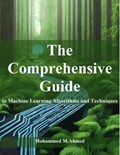Machine Learning has rapidly grown into a pivotal technology, transforming various industries by enabling data-driven decision-making and predictive analytics. As the volume and complexity of data grows, the ability to leverage sophisticated ML algorithms becomes primary for researchers, practitioners, and enthusiasts alike. This book aims to serve as a rich resource, addressing most algorithms, methods, and techniques in this field. Offering insights into each method's theoretical foundations, practical applications, and strengths and weaknesses, also provides a robust framework for selecting the most appropriate technique for many projects and research endeavors.
This Book provides a comprehensive overview of various machine learning algorithms and techniques, categorized by their primary functions, such as regression, classification, clustering, optimization, and NLP. Each algorithm has been explained in terms of its main concept, purpose, use cases, mathematical background, loss function, pros and cons, and visual representation. This knowledge is crucial for selecting the right algorithm for specific problems and understanding the underlying mechanisms that drive their performance.
Machine learning algorithms are the engines driving sophisticated predictive modeling and artificial intelligence. The landscape of ML methods is vast and varied, involving simple linear models and deep learning models. For researchers and practitioners, selecting a suitable algorithm can significantly affect the performance and success of a project. This choice is not trivial; it includes understanding the nature of the data, the problem at hand, and the trade-offs between different model characteristics such as bias, variance, interpretability, and computational efficiency.
This book is designed to help demystify the complex world of ML algorithms. Providing clear and cutting-edge explanations of each method, along with practical examples and illustrative figures, aims to bridge the gap between practical implementation and theoretical knowledge. Whether you are working on stock price prediction, energy consumption forecasting, natural language processing, or image recognition, this guide will supply you with the knowledge needed to make informed decisions about which ML methods to utilize.
What sets this book apart is its unique structured and comprehensive approach. Each chapter is dedicated to a specific algorithm or technique, offering a uniform template that includes:
Conceptual Overview: An explanation of the algorithm's main concepts and the problem it is supposed to deal with.
Practical Application: practical examples that show how the technique can be applied to solve real-world problems.
Mathematical Background: A look at the mathematical bases, providing the necessary for a deep understanding.
Pros and Cons: An evaluation of each method's strengths and weaknesses, assisting readers in making informed selections.
Illustrative Figures: Visualizations that boost comprehension and retain complex concepts.

